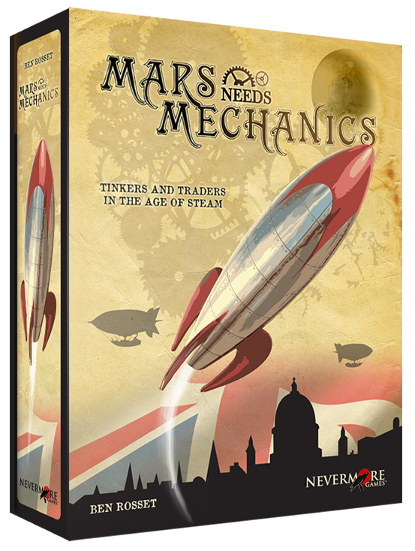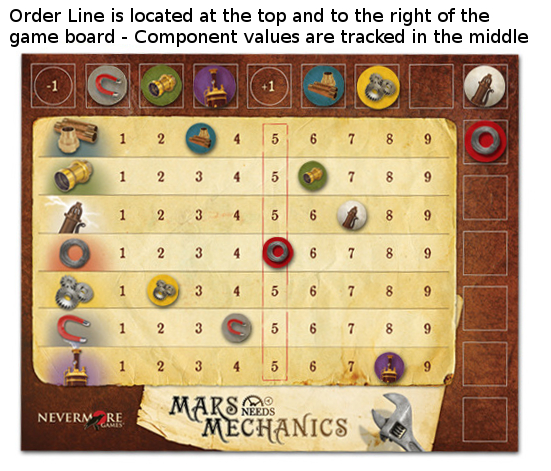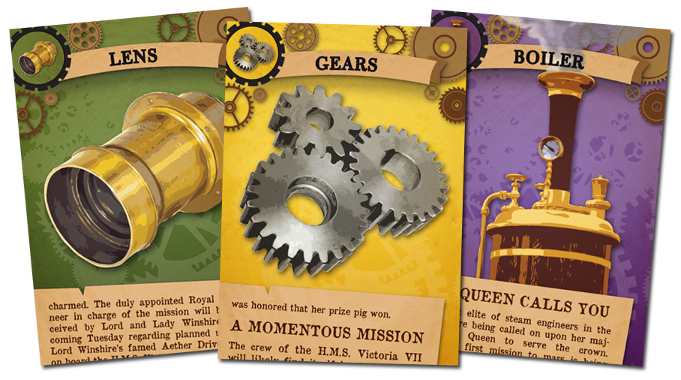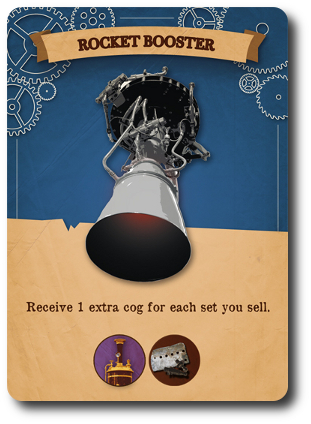Please Take Note: This is a review of the game’s final prototype. The art, game bits, and the rules discussed are all subject to change. The game is being reviewed on the components and the rules provided with the understanding that “what you see is not what you might get” when the game is published. If you like what you read and want to learn more, we encourage you to visit the game’s web page or visit the game’s Kickstarter campaign. Now that we have all that disclaimer junk out of the way, on with the review!

The Basics:
- For ages 8 and up (publisher suggests 10+)
- For 2 to 4 players
- Approximately 45 minutes to complete
Geek Skills:
- Counting & Math
- Logical & Critical Decision Making
- Reading
- Pattern/Color Matching
- Strategy & Tactics
- Risk vs. Reward
- Hand/Resource Management
- Auctioning, Bidding, & Trading
Learning Curve:
- Child – Easy
- Adult – Easy
Theme & Narrative:
- Prove to your peers that your scientific mind and engineer skills make you the best candidate for a Mars expedition…in the 1800’s
Endorsements:
- Gamer Geek approved!
- Parent Geek approved!
- Child Geek approved!
Overview
I, say! Have you heard, old boy? Those well-to-dos at the British Royal Academy of Space Exploration are at it again! They’ve got it in their heads that Mars is the next great land for us to tread on. I even hear that the Queen, of all people, is backing this lunacy! I don’t know about you, but those so-called “scientists” are messing with technology we cannot hope to understand or control! Dangerous, if you bloody well ask me. But think of the glory if it could be done! Mars! You know, I might have just talked myself into joining this little competition of theirs. After all, it’s all for a good cause and I would look simply smashing in a space suit!
Mars Needs Mechanics, by Nevermore Games, is comprised of 1 game board that represents the current market price of specific mechanical parts needed to build technology, 64 Component cards (that includes scrap metal, wire, aether tubes, piping, lenses, magnets, boilers, and gears), an assortment of Mechanism cards (that includes an Aether Drive, a Difference Engine, a Rocket Booster, and X-Ray Goggles), 7 Component tokens, 7 Component Value markers, an assortment of Cogs in different values (used as money and victory points), and a First Player marker. The entire design of the game is themed in the late 1800’s Victorian Steampunk era…that didn’t ever exist, which is a shame.
Note: It has come to our attention that our prototype game copy did not have all the components that will be part of the final release. Not included in this review are Player Markers, which are used to identify which Mechanism cards the player has built and has access to. Their use in the game is not mentioned here because this specific game component was not used by us, nor was it noted in our copy of the rules. It is important to mention them as they will make the use of Mechanism cards easier for players.
Game Set Up
To set up the game, first place the game board in the middle of the playing area. Most of the game will be taking place directly in front of the players, but the board will need to be within easy reach of everyone at the table.
Second, randomly distribute the 7 Component tokens to the outside order line track of the game board on the first 7 spaces that have numbers. Place the 7 Component Value markers on their matching component row in the starting column value position of “5”.

Third, give each player 30 Cogs (placing all unused Cogs to the side of the game board) and 2 scrap metal Component cards (remove unused scrap metal Component cards from the game).
Fourth, shuffle the remaining Component cards and deal out 3 to each player. Players should keep these cards hidden from their opponents and add the previously dealt scrap metal Component cards to it to bring their total hand size to five cards. Deal out 8 Component cards, face-up, in a line below the game board. These represent the starting available components for purchase and is referred to as the market line. Place the Component deck to one side of the market line.

Example of some of the Component cards in the game
Fifth, select 4 Mechanism cards and place above the game board. These are the only Mechanisms the players can use during the game. Remove unused Mechanism cards for the duration of the game.

Example of one of the Mechanism cards in the game
That’s it! Time to play! Determine who the first players is, give them the First Player marker, and get to work.
Let the Contest Begin!
The game is played in rounds with each player taking up to two actions during their turn in the round. Once a player’s turn is over, it is the next player’s turn going clockwise. This continues until the end of the round condition is met. The actions are as follows and can be taken in any order:
Primary Action
This is a mandatory action that must be taken by all players on their turn. A player may either purchase one component currently in the market line or pass.
To purchase a component, the player pays the amount the component is currently worth according to the matching Component Value marker on the game board. All Cogs are paid directly to the pile and a player is welcome to make change, but can never borrow Cogs or go in debt. All purchased Component cards go directly into the player’s hand. The player may now take an optional action.
Purchased Component cards are not replaced on the market line at this time. As soon as a Component card is purchased, the matching Component token is sent to the front of the order line, essentially leaping over all the other Component tokens to be put in the front, signifying that those Components are now in demand. By doing so, the market will adjust the Component’s value at the end of the round. Essentially, this means the players are directly controlling the price and demand for Components, but they have no influence on the supply.
To pass, the player need only politely decline to take their primary action and go directly to their optional action.
Optional Action
The player has two available optional actions that they can take. These are building a mechanism or breaking down a mechanism.
To build a mechanism, the player announces which available Mechanism card they want to build and show the required Component cards needed (these are indicated on the Mechanism card). Players can only build a mechanism once per turn. The Component cards they use to build the mechanism are set aside at this time and are no longer available to the player while they are using the mechanism, but nor are they discarded. This Mechanism card is now available to be used by the player, but is not owned by them. By building a mechanism, the player gains the right to use it. The function of the mechanisms are widely diverse and the players are in charge of knowing when and how best to use them, in accordance to the Mechanism card’s instructions.
To break down a mechanism, the player collects the Component cards used to build it and places them back into their hand. Players can only break down a mechanism once per turn. The Mechanism card’s function is now unavailable to the player.
Note that a player can build, break down, or do both to a mechanism at anytime during their turn, but not to the same Mechanism card. Players are limited to only building one mechanism at a time, unless otherwise noted by another Mechanism card.
Ending the Round
The round ends when one of the two following conditions are met:
- All Component cards on the market line have been purchased (wherein the currently active player must complete their turn before the round ends)
- All players pass as their primary action
Once the round ends, the following steps are completed in sequential order:
Step 1: Adjust Component Values
The Component values are now adjusted. This is done by first sliding all the Component tokens on the order line back so as to create a single line of Component tokens as it first appeared when the game was set up. The first seven squares in the order line have a numerical value. These are used to adjust the matching Component Value markers by either decreasing the value by one, not adjusting the value at all, or increasing the value by 1 in its current row.
Note: There is one exception to this step that only occurs during the final price adjustment of the game. When one of the two endgame conditions are met, the round is completed but the component values can only be increased if the component was purchased during the last round. Adjust the other component values as normal.
Step 2: Sell Sets
The players may now sell sets of Component cards they have collected based on the new market values. A set is 3 or more cards of the same component. The player shows the table their matching Component cards and then collects a number of Cogs based on the component’s current market value. For example, if the player showed 4 wire components that were currently worth 5 Cogs each, the player would collect 20 Cogs (4 x 5 = 20). A single scrap metal Component card can be used to complete a set, but do not have any value. Meaning, if a scrap metal Component card is used to complete a set of 3 cards, the player would only collect Cogs for the two non-scrap metal Component cards. The newly acquired Cogs are immediately added to the player’s pile of Cogs. Sold sets are discarded for the duration of the game.
Step 3: Market Restock
The market line is now restocked with whatever the market currently has available. This is done by randomly drawing 8 Component cards from the deck. A new round of play now begins with the First Player marker being given to the next player going clockwise.
Ending the Game
The game ends when either one of the two conditions are met:
- There are no Component cards left in the deck when restocking the market line
- No players purchased components from the market line for 2 consecutive rounds
At the end of the game, all the players now count their Cogs. The player with the most Cogs wins, demonstrating to the British Royal Academy of Space Exploration they have the “right stuff” for being sent to Mars.
To learn more about Mars Needs Mechanics, visit the game’s web page or visit the game’s Kickstarter campaign.
Prediction
My little geeks are just now starting to get into games where victory is dependent on how well they can buy, trade, and make money. We have played many games of Settlers of Catan and way too many games of Monopoly. In all cases, my little geeks are starting to demonstrate a basic understanding of what an item is worth, both in the short-term and the long-term. This is an excellent geek skill to start working on as soon as possible, as it helps the little geeks start to understand the value of money, time, and most importantly, patience.
Mars Needs Mechanics reads like a very easy game where the goal is to simply collect as many victory points as possible by trading in 3 or more cards of the same type. But this is an exceedingly rudimentary glance that does not do the game justice. Dig a bit deeper and you quickly see that this is a game of subtle market manipulation and crackerjack timing. Since the players must spend victory points to gain victory points, it is already understood that there is a real need to spend victory points wisely to obtain the biggest gain. This is only done by buying low and selling high. Simple economics 101, really. What makes it a little more complex is that the demand and price will go up for a component, but the market won’t necessarily provide that component based on the player’s needs. This means that components with a lot of activity will quickly go up in price and those that don’t, will quickly drop. This creates a very strange market wherein the prices are constantly fluctuating, but the supply never meets the demand.
This all sounds very complex, but because the component values are always visible, as well as what is available in the market, the players have a great deal of information. Unfortunately, no player has a crystal ball to help them see into the future, so all the decisions they make are rooted in the current round. This makes the game more complicated in the long-term, but exceptionally manageable and accessible to new players. Players are welcome to try to guess how the market will look, but they can only see how the market is shaping up to be in the next round; not several rounds into the future. And they have no idea what will be available in the market. Players need only focus on the “here and now” and make the best choices they can with the single goal of making the most Cogs as possible.
Teaching the game didn’t take long to any of our test group members. A player’s turn is very simple and a round is over fairly quickly. Players are limited by their card hand and their total Cogs. A player knows their total value and where they stand in terms of proximity to the winner’s circle at all times, since all the player’s Cogs are visible. This helps players keep track of not only their place in the game, but also how much more or less they need to start risking their position. For my 5-year-old, I’m afraid this game is a bit too advanced. We are still learning the subtle art of trading Sheep for Brick and why Park Place isn’t necessarily the best property to buy. For my 8-year-old, this is a great “next step” in games that involve an economic element.
And so, after teaching the game to my little geek, who had some excellent questions about price gauging and artificially inflating the market (which are terms he doesn’t know, but he does understand the concepts), we were ready to play the game. But before we did so, I asked him his thoughts on the game so far.
“This looks like a pretty easy game, but I know you, Dad. This game probably has some sneaky way of suddenly being really hard.” ~ Liam (age 8)
Hard? Hardly. But the game is very dynamic in nature and a player must be ever vigilant to ensure they get the best deals. Let’s see if the time and focus we spend on the game is a good investment or if we end up spending our time poorly.
Final Word
As my little geek predicted, he was surprised by at the game’s hidden complexity. He made a lot of poor choices and purchased components when they were too high, quickly losing his buying power. In fact, we scrapped the first game because he put himself in a very poor position within 3 rounds of play. I cannot fault him for this as I did the exact same thing when I first played the game at Gen Con 2012 with the game designer, Mr. Ben Rosset. Mr. Rosset explained the game very well and even warned me about new player’s quickly chasing buys instead of looking at the long term investment. Apparently, I was the only one who didn’t listen at the table as I quickly lost most of my ability to purchase Component cards I needed. Luckily for my little geek, I saw it happening to him, too, and helped him out. Mr. Rosset, while being an excellent fellow, only smiled at me during the game and was more than happy to sit back and watch me spend myself into a hole.
Thanks for the help, Ben….
Games two and three were much improved and by the time the third game was coming to a close, he was doing exceptionally well. He had improved his ability to purchase intelligently, worked on multiple sets at a single time, but not too many, and even grabbed a Mechanism card to provide him with a perk or two during his turns. I was most pleased and his performance clearly demonstrated that the game can be taught and played to a little geek as young as 8-years-old.
For the Parent Geeks, they were blown away with how quickly the game snuck up on them and shouted, “SURPRISE! I’M HARDER THAN I LOOK!” Like me, they seemed to not listen to early hints that this was a game that was going to shift quickly. For those who don’t pay attention early on, the shift would feel rather violent. Halfway through the game, I had several Parent Geeks raise their hands into the air and say, “OH, NOW I GET I!” After the game was over, they wanted to play it again and talked excitedly about it. Non-gamers were the same, and one non-gamer (who is a professional accountant – yes, he won the game) said, “this is a game where the market is a lot of fun to play in”. Well, heck…if an accountant says the market dynamics in the game are fun, you know it must be true.
Gamer Geeks were perhaps the most enthralled. I’d even go so far to say they were downright giggly about how much they were enjoying the game. They quickly saw how the market was manipulated, how easy it was to see problems coming, but how complicated it was to avoid them if you didn’t focus. The excellent mix of game information and high level of logical and critical thinking was like sweet-sweet candy to them and they gobbled it up. They wanted more when it was over. Much more.

My little geek gives me his best “I have no idea how to win this game” look – I have the same look, often
Gamer Geeks, this is an excellent game that plays light, plays fast, and will kick you in the teeth if you don’t watch what you are doing. This is a thinking game where its true nature is masked by the smooth game play. This is not a game you can win easily and the level of difficulty is based on two very important elements: the randomness of the market line and the gaming ability of your opponents. These two forces will work either for you or against you in the game, but never to a point where you are winning with ease. Even during games with our children, we had to think about what we wanted to do and how best to do it. The end result is a game we know you will love, will think about in detail, and be very impressed with. Based on your peer groups reaction to Mars Needs Mechanics, you need to get this game, as in get it “now”.
Parent Geeks, while your peer group’s reaction was significantly less geeky, the game was very well received and enjoyed. Parent Geeks very much liked the casual game play and the smooth transition from one round to the next. Parent Geeks never said the game felt too long, too short, to little, or too much. It was, in their opinion, an excellent game that challenged and entertained in equal measure. Non-gamers also enjoyed it, had no idea what “Steampunk” was, but didn’t care, either. They were having too much fun buying and selling to make points and giving their peers with more game play experience a run for their Cogs.
Child Geeks, this game will be a little difficult to understand at first. Not the game play, mind you, that’s pretty easy. In fact, you’ll understand how to play the game after only one turn. What you will not understand (and, honestly, still eludes me) is how to win the game. You must watch, at all times, the price of the components, take note what is being purchased by your opponents, and determine the probability of how the market will shift in the near and long term. Or, don’t and still have a wonderful time making the best choices you can based on what information you have available to you. Either way will work, honestly, but only one requires you to have a brain the size of a basketball.Based on your peer groups level of enjoyment with this game, we think Mars Needs Mechanics will entertain and challenge you.
There are a number of games I greatly enjoy playing but am absolutely no good at. Mars Needs Mechanics is one of those games. I’ll never turn down a chance to play it and will hardly ever walk away from the table the winner. But I don’t care – the game play experience is wonderful fun and the joy I get out of playing it far exceeds the momentary high I’d get from a victory. Although, let’s be honest, it does feel great to win.
Mars Needs Mechanics is a smart game. Smart in its design, smart in its presentation, and smart in its ability to adjust accordingly to the groups overall gaming skill. It has just enough weight to be a “thinker” and is not nearly light enough to be a game you can breeze through. It is casual but all the players will be thinking hard throughout the entire game, but not a point where the game is out of reach of any player. The end result is a deceptively simple and highly entertaining hand management and market manipulation game that is easy to teach, quick to learn, and downright difficult to master. Perfect!
If you are in the mood for a set collecting, commodity speculation, and market manipulation game, then do invest in Mars Needs Mechanics. We think it’s a smart buy.
This game was given to Father Geek as a review copy. Father Geek was not paid, bribed, wined, dined, or threatened in vain hopes of influencing this review. Such is the statuesque and legendary integrity of Father Geek.



